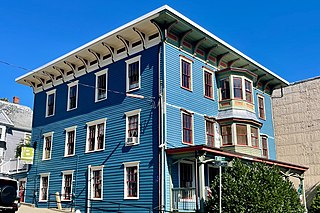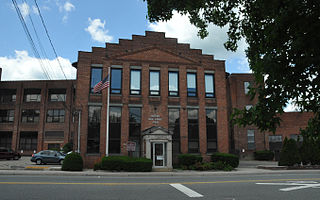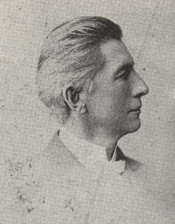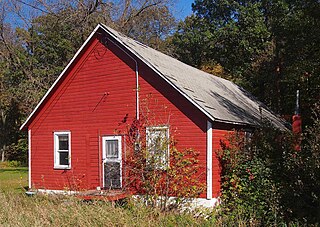Related Research Articles

A brass instrument is a musical instrument that produces sound by sympathetic vibration of air in a tubular resonator in sympathy with the vibration of the player's lips. Brass instruments are also called labrosones or labrophones, from Latin and Greek elements meaning 'lip' and 'sound'.

The flugelhorn, also spelled fluegelhorn, flugel horn, or flügelhorn, is a brass instrument that resembles the trumpet and cornet but has a wider, more conical bore. Like trumpets and cornets, most flugelhorns are pitched in B♭, though some are in C. It is a type of valved bugle, developed in Germany in the early 19th century from a traditional English valveless bugle. The first version of a valved bugle was sold by Heinrich Stölzel in Berlin in 1828. The valved bugle provided Adolphe Sax with the inspiration for his B♭ soprano (contralto) saxhorns, on which the modern-day flugelhorn is modelled.

Boonton is a town in Morris County, in the U.S. state of New Jersey. As of the 2020 United States census, the town's population was 8,815, an increase of 468 (+5.6%) from the 2010 census count of 8,347, which in turn reflected a decline of 149 (−1.8%) from the 8,496 counted in the 2000 census. The settlement was originally called "Boone-Towne" in 1761 in honor of the Colonial Governor Thomas Boone.

Butler is a borough in Morris County, in the U.S. state of New Jersey. As of the 2020 United States census, the borough's population was 8,047, an increase of 508 (+6.7%) from the 2010 census count of 7,539, which in turn reflected an increase of 119 (+1.6%) from the 7,420 counted in the 2000 census.

Bloomingdale is a borough in Passaic County, in the U.S. state of New Jersey. As of the 2020 United States census, the borough's population was 7,777, an increase of 121 (+1.6%) from the 2010 census count of 7,656, which in turn reflected an increase of 46 (+0.6%) from the 7,610 counted in the 2000 census.
In Britain, a brass band is a musical ensemble comprising a standardized range of brass and percussion instruments. The modern form of the brass band in the United Kingdom dates back to the 19th century, with a vibrant tradition of competition based around communities and local industry, with colliery bands being particularly notable. The Stalybridge Old Band was formed in 1809 and was perhaps the first civilian brass band in the world.

The second line is a tradition in parades organized by Social Aid and Pleasure Clubs (SAPCs) with brass band parades in New Orleans, Louisiana, United States. The "main line" or "first line" is the main section of the parade, or the members of the SAPC with the parading permit as well as the brass band. The second line consists of people who follow the band to enjoy the music, dance, and engage in community. The second line's style of traditional dance, in which participants dance and walk along with the SAPCs in a free-form style with parasols and handkerchiefs, is called "second-lining". It is one of the most foundationally Black American–retentive cultures in the United States. It has been called "the quintessential New Orleans art form – a jazz funeral without a body". Another significant difference from jazz funerals is that second line parades lack the slow hymns and dirges played at funerals.
C. G. Conn Ltd., Conn Instruments or commonly just Conn, is a former American manufacturer of musical instruments incorporated in 1915. It bought the production facilities owned by Charles Gerard Conn, a major figure in early manufacture of brasswinds and saxophones in the USA. Its early business was based primarily on brass instruments, which were manufactured in Elkhart, Indiana. During the 1950s the bulk of its sales revenue shifted to electric organs. In 1969 the company was sold in bankruptcy to the Crowell-Collier-MacMillan publishing company. Conn was divested of its Elkhart production facilities in 1970, leaving remaining production in satellite facilities and contractor sources.

The Jacksonville State University Marching Southerners is American marching band. Composed of students from all over the country, the Southerners and Marching Ballerinas perform for thousands each season.

The Spartan Marching Band (SMB) is the marching band of Michigan State University. The band has over 300 members and was founded in 1870. Notable music educator Leonard Falcone directed the band from 1927 through 1967.

The Purdue "All-American" Marching Band is the marching band of Purdue University and performs at Purdue Boilermakers football games. The AAMB is also the official band of the Indianapolis 500 race, having held the position since 1919.

A brass band is a musical ensemble generally consisting primarily of brass instruments, most often with a percussion section. Ensembles that include brass and woodwind instruments can in certain traditions also be termed brass bands, but may be more correctly termed military bands, concert bands, or "brass and reed" bands.

The Marching Illini is the marching band of the University of Illinois Urbana-Champaign. The Marching Illini is an organization which annually includes approximately 400 students enrolled in the University of Illinois, and Parkland College. It was founded in 1867 and primarily performs at Illini football games as well as other events around campus.
The Franklin Silver Cornet Band, formed in 1856, is one of the oldest volunteer community bands in the United States. The band plays concerts throughout the summer months in Franklin, Pennsylvania as well as an indoor concert in Franklin's Barrow-Civic Theatre the day after Thanksgiving.

Charles Gerard Conn was an entrepreneur, band instrument manufacturer, newspaper publisher, and U.S. Representative from Indiana for one term from 1893 to 1895.

F. E. Olds was a manufacturer of musical instruments founded by Frank Ellsworth Olds in Los Angeles, California in the early 1900s. The company made brass instruments, especially trombones, cornets, and trumpets.
The Boston Musical Instrument Company was an American manufacturer of brass band instruments in the late 19th and early 20th centuries located in Boston, Massachusetts.

Ernst Albert Couturier was best known as a cornet player who toured as a "virtuoso" performer on the concert programs of bands of the day. He promoted the Holton Band Instrument Company for a decade in that capacity before applying his own unique inventions to the production of his own line of brass band instruments between 1918 and 1923.
The Stonewall Brigade Band is a community concert band based in Staunton, Virginia. It is the United States's oldest continuous community band sponsored by local government and funded, in part, by tax monies. Originally a brass band, the band was formed in 1855 as the Mountain Sax Horn Band. It was also called Turner's Silver Cornet Band by 1859, for its first director, A. J. Turner. At the onset of the American Civil War, the band was mustered into the 5th Virginia Infantry Regiment, part of the Stonewall Brigade under Stonewall Jackson.

Germania Hall is a historic community hall in Germania Township, Minnesota, United States. It was built in 1917 as a practice and performing space for a community band. Later it served as a general event venue for its rural township. The building was listed on the National Register of Historic Places in 1995 for having local significance in the themes of performing arts and social history. It was nominated for being a rare surviving example of a community band hall, and for its long service as the township's social and political center.
References
- ↑ 50th Anniversary Booklet, The Bloomingdale Cornet Band, 1934.
- ↑ The History of Bloomingdale, 50th Anniversary Booklet, 1968.
- ↑ Article, The Boonton Bulletin, September 11, 1884
- ↑ Article, The Iron Era, April 18, 1885
- ↑ Article, The Boonton Builletin, April 23, 1885
- ↑ Article, The Boonton Builletin, September 24, 1885